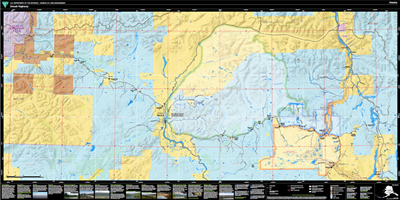Tangle Lakes Archaeological District
The Tangle Lakes Archaeological District (TLAD) is a 226,660 acre Archaeological District in central Alaska listed on the National Register of Historic Places. This national list contains most of the culturally and historically important places in the United States. The TLAD was nominated to this list in 1971 because of its present and future contributions to the understanding of the prehistory of central Alaska and North America. This Archaeological District is the largest in the North American subarctic and contains the densest grouping (over 600 documented sites) of early prehistoric archaeology in Alaska. The archaeology of the area is managed by two agencies: the BLM manages about 185,321 acres south of the Denali Highway and north of the highway in the Delta Wild and Scenic River Corridor. The State of Alaska’s Department of Natural Resources manages about 41,339 acres north of the highway.
A Story of Adaptation TLAD Prehistory and History:
The Tangle Lakes area contains a record of subsistence use by indigenous people over 10,000 years ago. The earliest people using the area likely focused on hunting caribou around an ancient set of lakes that existed between 7,900 years ago and perhaps 3,600 years ago. While caribou crossing the lakes were their main subsistence resource, they probably harvested other animals, fish and plants to supplement their diets.
Trails and Off-Highway Vehicles
 For the protection of cultural resources, Off-highway Vehicles are required to stay on designated trails within the TLAD.
For the protection of cultural resources, Off-highway Vehicles are required to stay on designated trails within the TLAD.
BLM-managed Lands: Off-highway vehicles have been used by hunters and recreational users in TLAD for several decades. Travel in the BLM managed TLAD is limited to four designated trails between May 16 through October 15 or until such time that adequate snow cover or ground frost is present. Several nondesignated trails have developed inside TLAD from people riding off the designated trails. These illegal trails are damaging irreplaceable archaeological sites that cannot be restored to their former condition. The violation of this regulation is punishable by a fine not to exceed $1,000 and/or imprisonment not to exceed 12 months as defined under 43 Code of Federal Regulations 8360.0-7.
State of Alaska managed lands: Between May 18 and October 18, use of motorized vehicles are limited to the designated trails only within the Tangle Lakes Archaeological District. Between October 19 and May 17, use of motorized vehicles are limited to the designated trails, except as provided in 11 AAC 96.020(a)(1)(D) and (E) if snow cover or ground frost is sufficient to prevent damage to archaeological values. Sufficient snow cover means an average of 1 foot of snow, with a minimum of 6 inches. Sufficient ground frost means minimum of 6 inches.

